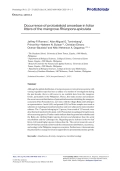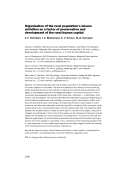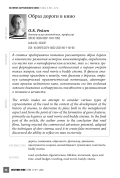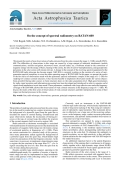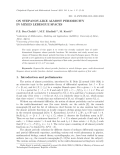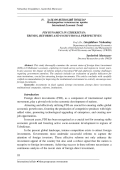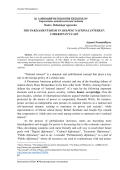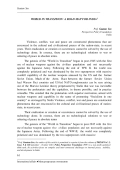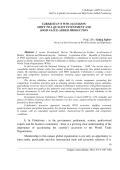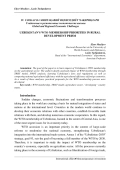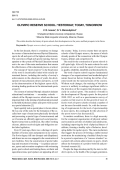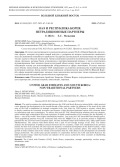Although the global distribution of eumycetozoans in terrestrial ecosystems with varying vegetation types has been a subject of a number of investigations during the past decade, there is still scarce to no available data from the mangrove forests, particularly in the Philippines. Hence, this study assesses and compares the occurrence and distribution of protosteloid amoebae inhabiting the mangrove ecosystem of San Fernando City, La Union, with the villages Biday and Catbangen as representatives. Aerial (AL) and ground (GL) leaf litter samples were used as substrates in isolating protosteloid amoebae and were subjected to moist chamber cultures. The 17 species belonging to 12 genera, from a total of 125 records, were described and reported in this study, with Protostelium mycophagum being the most often occurring species. Further results indicate that the ground microhabitat and the Biday site exhibited higher species diversity and abundance than the aerial microhabitat and the Catbangen site. Regarding species richness in the two leaf litters, GL hosted higher species richness than AL. The current research is one of the few that has assessed and surveyed the eumycetozoan distribution, occurrence, and ecology in the Philippine mangrove ecosystem. Furthermore, it demonstrates the potential for a mangrove forest to support diverse protosteloid amoebae growth.
The article describes the role of leisure activities in the effective development of human capital in rural areas. The article is based on the results of the monitoring study conducted by the survey method to examine the cultural-leisure activities of villagers in the Belgorod district of the Belgorod Region. The culture of leisure in the rural society was assessed according to the three main indicators - institutional, information and sociological. The authors identified the following rural groups depending on cultural-leisure preferences and activities: consumer (50%), spontaneous (18%), limited (17%) and active (15%). According to the features of leisure, seven types of cultural-leisure activities were identified: entertaining (28%), imitative (20%), consumer (19%), conservative (10%), contemplative (9%), cultural-creative (9%) and non-traditional (5%). Despite the declared desire to take an active part in cultural events (83%), only 10% of villagers do participate in them. One of the reasons is the discrepancy between cultural needs and the ability of cultural institutions to satisfy them. The authors note that the effective organization of cultural-leisure activities influences both formation and reproduction of human capital in rural areas. Thus, indicators of the improving quality of life in rural areas are not only modernized production and high wages but also the development of educational and cultural-leisure institutions.
В статье предпринята попытка рассмотреть образ дороги в контексте развития истории кинематографа, определить его место как в метафорическом аспекте, так и с точки зрения формирования жанровых особенностей в первую очередь таких жанров, как road movie и buddy cinema. В финале статьи автор приходит к выводу, что фильмы о дорогах, отринув коммерческий приключенческий потенциал, адаптировали приемы медленного кино, использовали его для создания ложного движения и обнаружили способность к размышлению о человеке в вечности.
We present the results of newobservations of radio emission from the solar corona in the range 1–3 GHz usingRATAN- 600. The difficulties of observations in this range are caused by a large amount of industrial interference (mobile communications, satellite navigation, microwave ovens, aircraft radars, etc.). Problems related to the conversion of magnetic energy into the energy of flares, heating of the corona, the role of narrow-band phenomena, and quasiperiodic pulsations in the solar corona still remain relevant. A change in the concept of the receiving spectral equipment for the RATAN-600 radio telescope has become urgent. SAO RAS is currently working on the creation of a series of nextgeneration spectral complexes to cover the entire operating range of RATAN-600. In this paper, we present the results of the first series of observations made with the panoramic spectral radiometric complex in the range of 1–3 GHz for studying low-contrast coronal structures. It has become feasible to implement observation modes for various objects: from powerful flaring radio sources to faint structures down to the radio granulation level. High-speed instruments for radio signal reception and information processing have been developed and introduced in order to separate useful signals from interference in real-time mode. These parameters, combined with a large effective area and wide frequency coverage of RATAN-600, allowed for observations of weak coronal structures in the frequency range of 1–3 GHz. We discuss the results of the first series of observations of weak coronal structures and their interpretation in terms of their impact on thermal processes in the corona.
The main purpose of this paper is to revisit the recently analyzed class of multidimensional Stepanov almost periodic functions. We introduce and study several new classes of Stepanov-like almost periodic functions in the mixed Lebesgue spaces. We also provide a new application of multi-dimensional Stepanov almost periodic functions to the abstract nonautonomous differential equations of first order, provided that all components of the exponent p_ ∈ [1, ∞)n are equal.
Ushbu tadqiqot O’zbekiston iqtisodiyotidagi to’g’ridan-to’g’ri xorijiy investitsiyalarning hozirgi holatini chuqur o’rganib chiqadi, uning so’nggi yillardagi tarmoq va mintaqalardagi tendentsiyalarini o’rganadi. Shuningdek, u FDINI rivojlantirishga qaratilgan islohotlarning ta’sirini baholaydi va hukumat e’tiborini talab qiladigan mavjud muammolarni hal qiladi. Tahlil xorijiy investitsiyalarni jalb qilish uchun muhim bo’lgan davlat muassasalari uchun sifat ko’rsatkichlarini baholashni o’z ichiga oladi. Maqola ko’proq xorijiy investitsiyalarni faol ravishda rag’batlantirish uchun institutsional muhitni yaxshilash bo’yicha puxta ishlab chiqilgan tavsiyalar bilan yakunlanadi.
Ushbu maqola parlament diplomatiyasi, uni ilmiy tushuntirish, uning shakllari va uni amalga oshirish usullariga bag’ishlangan. Shuningdek, muallif ushbu maqolada O’zbekiston Respublikasi oliy Majlisining jonlangan parlamentlararo munosabatlari, uning milliy manfaatlarni ifodalashdagi o’rni va Oliy Majlisning O’zbekiston tashqi siyosatini amalga oshirishdagi huquqiy bazasi haqida ma’lumot beradi.
Zo’ravonlik, mojaro, urush va tinchlik-bu so’nggi yillarda milliy davlatning madaniy va tsivilizatsiya praktikasida saqlanib qolgan hodisalar. Ularni yo’q qilish yoki yaratish yoki sodir bo’lishini faqat texnologiya yordamida hal qilib bo’lmaydi. Aslida, urush yoki mutlaq ma’noda tinchlikni o’rnatish uchun texnologik echimlar mavjud emas.
Prezidentning yaqinda qabul qilingan “bozor islohotlarini yanada jadallashtirish va O’zbekiston Respublikasi Milliy qonunchiligini JST shartnomalariga uyg’unlashtirish chora-tadbirlari to’g’risida” gi Farmoni O’zbekistonning bozor islohotlari va global iqtisodiy integratsiyaga sodiqligini yana bir bor ta’kidladi.
Shu bilan O’zbekiston Jahon savdo tashkilotiga (JST) a’zo bo’lish yo’lida muhim qadam tashlamoqda. “O’zbekiston – 2030” milliy strategiyasiga muvofiq, farmon bozor islohotlarini mustahkamlash, erkin bozor tamoyillarini mustahkamlash va jahon ishlab chiqarish zanjirlariga integratsiyalashuvga qaratilgan. Milliy qonunchilikni JST standartlariga moslashtirish orqali O’zbekistonda yanada ochiq va raqobatbardosh ishbilarmonlik muhiti yaratilib, bozorning barcha ishtirokchilari uchun teng imkoniyatlar yaratilmoqda.
Farmon adolatli raqobatni targ’ib qilib, ayrim kompaniyalarning eksklyuziv huquqlarini bekor qiladi. Unda bojxona to’lovlarini muvofiqlashtirish, eksport subsidiyalarini bekor qilish, aktsiz solig’i stavkalarini 2027 yilga qadar unifikatsiya qilish, O’zbekiston savdo siyosatini jahon standartlariga moslashtirish kabi ustuvor yo’nalishlar belgilangan.
Ushbu harakat asosiy sohalarda yangi yo’llarni ochib beradi va xorijiy investitsiyalar uchun zarur rag’bat va imkoniyatlar yaratadi. Shuningdek, u ishbilarmonlik muhitida shaffoflik va ishonchlilikni oshirishdan foyda ko’radi. Iqtisodchilar O’zbekistonning JSTga yalpi ichki mahsulotni har yili 1,2 foizga oshirish va besh yil davomida 3 milliard dollarlik to’g’ridan-to’g’ri xorijiy investitsiyalarni jalb etishga qo’shilishini bashorat qilib, ushbu islohotlarning transformatsion salohiyatini ta’kidlamoqda.
O’zbekistonning JSTga a’zo bo’lish borasidagi faol yondashuvi iqtisodiy modernizatsiya va global integratsiyani anglatadi. Xorijiy biznes uchun bu adolatli va raqobat sharoitlari bilan ajralib turadigan kengayib borayotgan mintaqaviy bozor bilan shug’ullanish uchun noyob imkoniyatdir.
Ma’ruzaning maqsadi O’zbekiston JSTga a’zoligining qishloq xo’jaligiga ta’sirini o’rganishdan iborat. Mualliflar Trist modeli, SVOT tahlili, O’zbekiston qonunlari va qoidalarini o’rganish hamda milliy qishloq xo’jaligi samaradorligini xorijiy mamlakatlar qishloq xo’jaligi samaradorligi bilan taqqoslash orqali JSTga a’zolikning ta’sirini chuqur tahlil qildilar. Ushbu tahlillar natijasida JSTga a’zolik jarayoni bo’yicha amaliy takliflar ishlab chiqildi.
This article describes the history of sports schools, their development over the years, and their prospects in the future.
В статье рассматриваются взаимоотношения между ОАЭ и Южной Кореей в различных сферах, которые получили новый импульс к развитию во втором десятилетии нынешнего века под влиянием потребности арабского государства Залива решать поставленные им стратегические задачи в области экономики. Автор анализирует развитие политических контактов между двумя странами, которые были установлены в предшествовавший период, а затем были существенно активизированы. Был налажен также культурный обмен между этими странами, что создало необходимую основу для интенсификации сотрудничества в сфере экономики. В статье показан рост объема инвестиций, которые ОАЭ направляет на развитие производства возобновляемых источников энергии. Автор уделяет также внимание сотрудничеству между ОАЭ и Южной Кореей в сфере ядерной энергетики, которое стало показателем достигнутых этими странами успехов в установлении отношений стратегического партнерства.
